Europeans
Europeans in Kenya primarily consist of descendants of British colonialists.
Mid 16th century: The first missionaries, the Portuguese Roman Catholics settled on the EAC and established monasteries at Mombasa and Lamu by 1557.
In 1844, Dr. Ludwig Krapf, a German Christian missionary, linguist, explorer and traveller came to the East African Coast (EAC) sent by the Anglican Church Missionary Society (CMS), and was granted a permit by the Sultan of Zanzibar, Seyyid Said, to set up a mission at the coastal city of Mombasa.
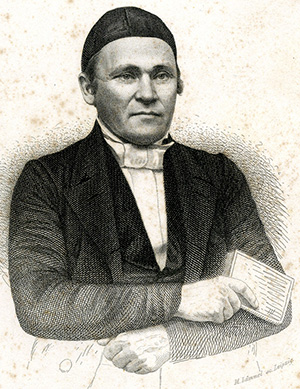
Johann Ludwig Krapf
After the death of his wife and daughter from Malaria, Krapf moved to Rabai on the coastal hills and started a mission station at Rabai. He learnt the languages of the Mijikenda and Swahili and wrote the first dictionary and grammar of the Swahili language.
On June 10, 1846 Krapf was joined by another southwest German Lutheran missionary, Johannes Rebmann, also sent by the CMS. Together they set up a mission station at Rabai Mpya (New or Little Rabai). They arrived at Rabai of August 25, 1846 where they dwelt for the next three and a half years (August 1846-April 1850).
1848: Missionaries’ exploration
CMS missionaries, Dr Ludwig Krapf and Johannes Rebmann, were the first Europeans to penetrate into the hinterland of the EAC with the help of celebrated Kamba Chief Kivoi of Kitui. Their mission to the interior was not trade but rather the spread of Christianity. They sent reports of snowcapped mountains in the hinterland of the East African Coast.
1863
Krapf and Rebmann’s reports of snowcapped mountains in 1849 and 1848 respectively were received with scepticism/disbelief. The scientific journals of both Germany and England discredited the idea that mountains with perpetual snow could be found just under the equator, and the suggestion was offered that the summit seen—if at all—must be “a cone of porphyry”. However, the travels of Baron Van der Decken in 1863 subsequently satisfied the world of the reality of the discovery of snowcapped mountains near the equator in East Africa.
1883-1885
Joseph Thompson, a Scottish geologist and explorer, was commissioned by the Royal Geological Society of England to carry out an expedition to explore a route from the EAC to the northern shores of Lake Victoria (source of River Nile). Thompson was the first European to walk from Mombasa to Lake Victoria.
The Royal Geographical Society is a British learned society founded in 1830 for the advancement of geographical sciences.
Thomson’s expedition had been commissioned as per the request of British Empire traders who were demanding a route that would avoid the Maasai and the hostile Germans who were competing for trade in the area.
Explorers reports on the raw potential of East Africa sparked the interest of European powers for control of the regions as protectorates and colonies
Pioneering businessmen in the EAC such as the German Karl Peters and Scot William Mackinnon compelled their home governments (Germany and Britain, respectively) to protect their interests in the region.
In 1885, the East African territories were carved-up between Britain, Germany and France. The Germans took Tanganyika (present day Tanzania and Zanzibar), the British assumed control of British East Africa (the region that was later divided into Kenya and Uganda), whilst the French took the island of Madagascar.
Further north, South of Lamu, the German brothers Clemens and Gustav Denhardt negotiated a treaty with Ahmed ibn Fumo Bakari, the first mfalme (Swahili for sultan or king) of Witu who ceded, on 8 April 1885, 25 square miles of territory to the brothers’ “Tana Company”, and the remainder of the Wituland became the German Protectorate of Wituland (Deutsch-Witu) on 27 May 1885. The Reich was represented there by the German Residents: Gustav Denhardt (1856–1917; in office 8 April 1885 – 1 July 1890) and his deputy Clemens Andreas Denhardt (1852–1928). German rule was relatively mild, and the territory continued being a haven for escaped slaves.
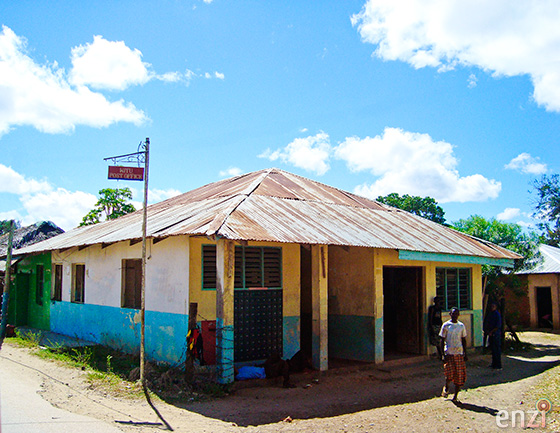
Witu post office
Early 1880s: Berlin conference and European occupation of Africa
Berlin conference of 1884-85 was held in Germany in order for European powers to agree on the regions in Africa each power had the right to ‘pursue’ legal ownership of land. This conference marked the official start of the Scramble for Africa by European powers: Belgium, France, Germany, Italy, Portugal, Spain, United Kingdom (Britain), Independent states.
European settlement, agriculture and ‘native reserves’
European settlement started in 1890. Two or three Europeans who settled at Mua Hills near Machakos marked the southern limit of European settlement.
Sir Charles Norton Eliot, commissioner of British East Africa at the beginning of the 20th century (December 1900-1904), is credited with having initiated the policy of white supremacy in the British East Africa protectorate (now Kenya).
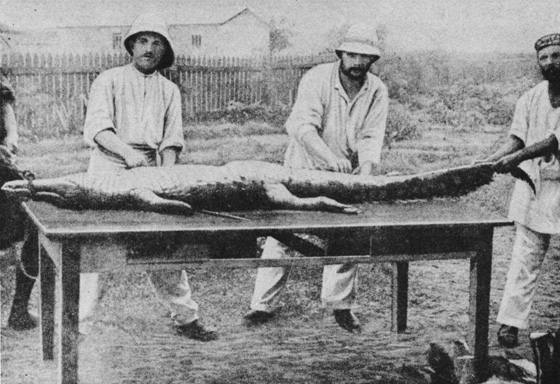
British colonialists skin a crocodile.
From 1902, the British government encouraged white settlers to settle in Kenya. In April 1902, the first application for land in British East Africa was made by the East Africa Syndicate-a company in which financiers belonging to the British South Africa Company sought a grant of 500 sq.m.; this was followed by other applications for considerable areas.
European settlement began in earnest after the promulgation of the Crown Lands Ordinance of 1902. The Ordinance declared that all land belonged to the British Imperial Government.
During the first phase of European settlement in Kenya, 1902 to 1908, nearly all alienated land was found around the railway towns and at points not far from it. The land open to white settlement during this period was the area between Kibwezi in the east and Fort Ternan station in the west. The second phase of European settlement was into the Uasin Gishu Plateau, centring around the town of Eldoret. The third phase of European settlement started after the First World War with the allocation of land to demobilised soldiers in the Kenyan highlands under the ex-soldiers settlement schemes.
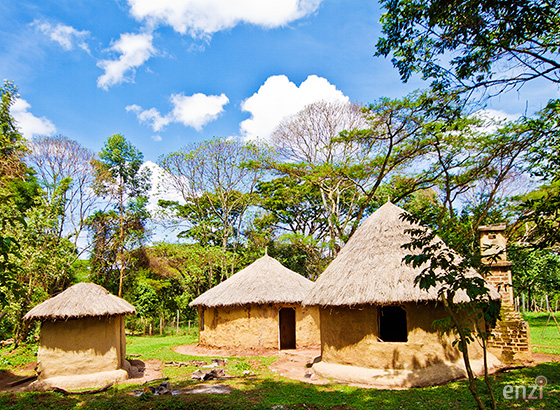
Early white settler homestead at Kitale museum.
Sir Charles Eliot had reserved all the land from Kiu to Fort Ternan for white settlers, and in 1907 the colonial secretary, Victor Alexander Bruce, 9th Earl of Elgin, pledged that the area would be reserved for Europeans.
During the early part of the 20th century, the interior central highlands were settled by British and other European farmers. By the 1930s, approximately 30,000 white settlers lived in the area.
The Crown Lands ordinance of 1902 provided for sale of land and leases to settlers. The ordinance underlined that the Crown had original title to land and that where Africans vacated or deserted the land, that land was considered waste and reverted back to the Crown to be given to the settlers.
There were two types of land tenure: leasehold and freehold. The Crown Lands Ordinance of 1902 provided that the settler-farmers would lease land for 99 years and not 21 years, as per the Ordinance of 1897. Each settler was to be given 160 acres free of charge as an inducement to farm. In 1915 the leasehold terms were raised from 99 years to 999 years further stimulating European immigration.
1903 saw the arrival of hundreds of prospective settlers, chiefly from South Africa. This led to a decision not to entertain more applications for large areas of land.
White settlement in the early years of the 20th century was led by Lord Delamere, a pugnacious gentleman farmer from Chesire, England. By 1912, Delamere and his followers had shifted to the highlands near Nairobi and established mixed agricultural farms.
Lord Delamere and many other pioneer farmers suffered a lot in their farming ventures as little was known of the kind of crops to grow in the region. By trial and error they established plantations of coffee, tea, sisal, cotton, pineapples, wattle trees and pyrethrum. Cattle rearing also proved a profitable undertaking, spurring the establishment of huge ranches.
In 1907, the the Legislative Council was established, Lord Delamere was one of the three non-official members appointed by the governor to represent white settler interests.
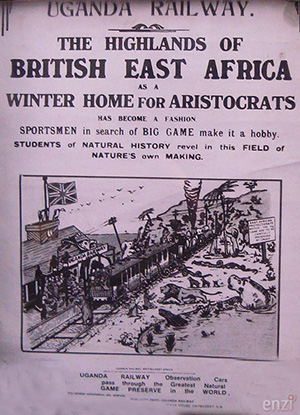
An advertisement in England targetting potential white settlers to British East Africa.
Lord Delamere was the settlers unofficial leader and, in some measure, spokesman for 30 years. He was a member of the Legislative Council, the Executive Council, and in 1907, became president of the Colonists’ Association.
The settlers, led by Lord Delamere demanded for elected representatives in to the Legislative Council (Legco). This demand did not include Asians and Africans. In 1916, European settlers were allowed to elect representatives who sat on the non-official (opposition) side of the Legco.
In 1919, the European settlers won the right to elect representatives to the legislative council. In the same year, they established the British East Africa Maize Growers Association, which evolved into the Kenya Farmers Association four years later.
Altogether, the White Highlands comprised 17,000 square miles, or 15% of the size of the country. By 1960 some seven and a half million acres of the White Highlands had been alienated for European settler use.
In 1903 there were about 100 settlers. There was an influx of settlers between 1908 and 1914, with 1908 marking the peak of European settler immigration. In this year 280 Transvaal Boers embarked on a trek across Kenya with completed houses, wagons and ploughs and settled in the Uasin Gishu plateau for wheat farming. By 1914 there were about 1,000 settlers in Kenya. European settlers increased in number, by the 1950s the White population numbered over 80,000.
The settler population was increased by the immigration of some 1,000 British ex-soldiers who had fought in the First World War. They were granted land in Nanyuki, Nyahururu (formerly Thomson’s Falls) and Trans Nzoia Districts.
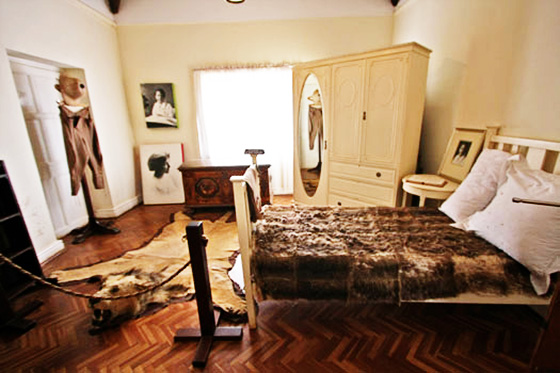
Denys Finch Hattons bedroom in Karen Blixens home.
The term ‘settler’ as it became current in usage meant a European who was resident in Kenya. While the majority of these were farmers, there was a minority which consisted of businessmen, civil servants and workers.
The white settlers practised large scale farming of agricultural produce such as wheat, pineapples, coffee, tea, pyrethrum, wattle trees and flowers for the European market. Some of them had ranches.
Preceeding the second world war, a few Jewish families escaping the holocaust also settled in Kenya, some as farm managers or the white settler farmers.
In 1959 the British government revoked the Land Ordinance of 1939 and opened up the White Highlands to the Africans.
By the mid-1950s the cultivation of cash crops, such as coffee, tea and pyrethrum, was opened to the Africans. The settlers resented this as they viewed it as competition.
Alienation of land was one of Africans main grievances during the struggle for independence.
Today, there is a substantial remnant colonial population (or their descendants) around the country as well as recent immigration of European retirees to the popular holiday destinations of the South Coast, Lamu and Malindi. There is also a growing population of younger expatriate, diplomatic and military workers from North America and other European countries.
